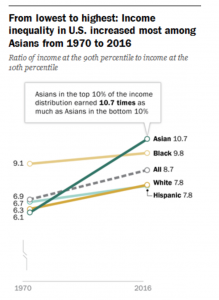Have you heard of the Model Minority Myth? I hadn’t either for the longest time until I did the research, and suddenly I was seeing it everywhere. The Model Minority Myth states that Asian Americans are the ideal or “model” racial minority because they are rich, successful, smart, and don’t challenge the racial imbalance and inequality of our country. This past year, anti-Asian hate crimes have filled the news, leaving our nation with big questions about anti-Asian racism. Our Senior Editor, who is of Asian descent, recently wrote this article highlighting her reactions, along with the Asian community’s reaction to the uptick in Asian hate crimes her community has faced the past year. Today, we’re going to take a look at the Model Minority Myth, what it is and how it affects the public view of Asian targeted racism.

What Is The Model Minority Myth?
To understand the model minority myth, you’ll have to acknowledge prevalent stereotypes that create a false narrative around Asian Americans. We’ve all heard of the main ones: Asians are smart, their parents are strict, they play instruments like the piano, they’re polite, they are law-abiding, they are successful. This may be confusing to you, because at least these stereotypes are mostly positive, unlike negative stereotypes that are in place about other groups.
One of many issues about these stereotypes is that they are often used to show that racism in America is at a minimum. These stereotypes are often used in comparison to other groups, most often being Black Americans. Janelle Wong, the director of Asian American Studies at the University of Maryland, College Park said the stereotypes are often used as “a flawed comparison between Asian Americans and other groups, particularly Black Americans, to argue that racism, including more than two centuries of black enslavement, can be overcome by hard work and strong family values.” This has caused a lasting wedge between Asian Americans and other minority groups.
The “positive” stereotypes about Asian Americans have been used as a weapon against Black Americans and other communities, used to compare the two and make it seem like systemic racism does not have a hand in their struggles. These stereotypes are not only used against other communities but are also used to ignore the differences and diversity within the Asian American community. To say all Asians are all rich and successful would ignore the varying poverty rates of Asian populations. According to Pew Research Center, Asians are the most divided economic group in the US. These stereotypes also diminish individuality and set expectations that can lead to further discrimination and hardships.
“The 90/10 ratio varies widely by race and ethnicity. In 2016, Asians at the 90th percentile of their income distribution had 10.7 times the income of Asians at the 10th percentile. The 90/10 ratio among Asians was notably greater than the ratio among blacks (9.8), whites (7.8) and Hispanics (7.8).”

How Does The Model Minority Myth Affect Asian Americans?
“Our research shows that the model minority myth does 3 things: 1, obscures anti-Asian American racism; 2, renders Asian Americans invisible to broader society; and 3, implies that Asian Americans don’t need anti-racist programs.” @pewresearch https://t.co/CiLAuX1KCF
— Dr. Margaret Chin (陈美瑺) (@ProfMChin) April 23, 2021
In this TIME story by Viet Thanh Nguyen, he explains that his parents owned a Vietnamese grocery store in the early 1980s in San Jose. After their store had become successful, a sign was placed in a nearby storefront that stated “Another American driven out of business by the Vietnamese.”
“Somehow the person who wrote this sign saw people like my mother and my father as less than human, as an enemy,” Nguyen wrote. “This is why I am not surprised by the rising tide of anti-Asian racism in this country. Sickened, yes, to hear of a woman splashed with acid on her doorstep … numerous people being called the “Chinese virus” or the “chink virus” or told to go to China, even if they are not of Chinese descent.… This is what it means to be a model minority: to be invisible in most circumstances because we are doing what we are supposed to be doing, like my parents, until we become hypervisible because we are doing what we do too well, like the Korean shopkeepers. Then the model minority becomes the Asian invasion, and the Asian-American model minority, which had served to prove the success of capitalism, bears the blame when capitalism fails.”
Basically, the model minority trope states that Asian Americans are successful because they are hardworking and smart, but also because they don’t challenge the racial hierarchy of the United States. Once this line is crossed, as in the case of Nguyen’s parents’ shop doing better than a white American’s, they are no longer seen as harmless, and once again seen as a threat.
“Today, Americans rely on China and other Asian countries for cheap commodities that help Americans live the American Dream, then turn around and blame the Chinese for the loss of American jobs or the rise of American vulnerability to economic competition,” Nguyen wrote.
How Can I Negate The Model Minority Myth?
Even if you are enforcing a stereotype that seems positive, you must realize that all stereotypes are limiting and harmful. In order to negate the model minority myth, you must take a look at how you treat Asian Americans and if you have ever let any microaggressions slip out. If you’ve ever made a joke about your Asian friend not being smart enough, you are a part of the problem. Watch the way you discuss Asian stereotypes, watch the way you compare their hardships to that of other groups. We also need to elevate Asian voices and experiences and support media representation of Asians as normal people and not foreigners.
A few examples of positive Asian representations are Rachel Chu from Crazy Rich Asians, Lara Jean from To All The Boys I’ve Loved Before, Tahani and Jason from The Good Place, Devi Vishwakumar from Never Have I Ever, and Claudia from Netflix’s The Babysitters Club. Obviously, these few representations are not enough and we must be on the lookout for examples of the model minority in our media and try to replace it with positive, realistic role models.

We are here to elevate the voices and stories of Asian Americans, leave a comment to keep the conversation going.
To Continue Learning About Social Issues, Read These:
Asian Hate In America Is An Epidemic, We Discuss This Heavy Issue

